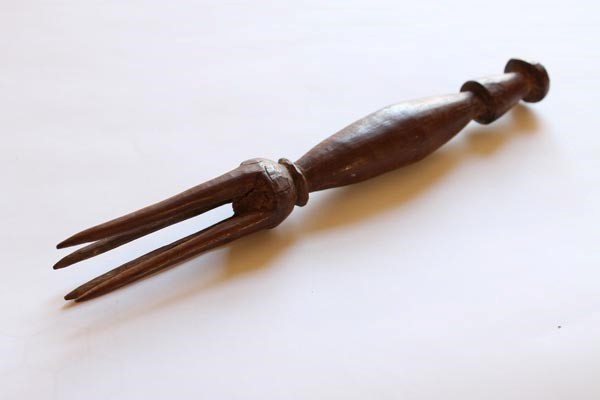Unknown
Cannibal’s Fork from Fiji
Cannibal's fork - or 'iculanibokoloa' - presented to Arthur Mahaffy by the grandson of the last King of Fiji.
By Emma Crosbie
The acquisition register entry for this artefact reads:
Cannibal fork, red wood, bobbin-shaped handle, four prongs. 9 ins. Forks of this pattern were reserved for the use of chiefs at cannibal feasts. “This was presented to me by Kandavu Levu, the grandson of the last ‘King’ of Fiji.” From the mountains of Viti Levu, Fiji Is.
Ethnographical specimens collected by the late Commissioner A.W. Mahaffy in the South Sea Islands. Bought. The provenance of the objects is taken from a catalogue written by the late A.W. Mahaffy.
What does the cannibal’s fork look like?
It is made from a reddish coloured wood with a carved cylindrical handle from which four thin prongs extend.

Figure 2: Cannibal fork NMIAE:1923.322
Where does it come from?
According to the National Museum’s acquisition register, it came from the mountains of the Fijian Island of Viti Levu, the largest of the Fijian Islands.
Who were cannibals’ forks used by?
The Museum’s register entry states that:
“Forks of this pattern were reserved for the use of chiefs at cannibal feasts.”
Other accounts too suggest that forks were used by, or to feed, high ranking members of society; however, a contemporary report from 1858 states that:
“The cannibal fork seems to be used for taking up morsels of the flesh when cooked as a hash, in which form the old people prefer it.”
The various accounts indicate that different styles of fork were probably used by different people.
Why did people participate in cannibalism?
Many of the 19th century accounts that still shape some of our perceptions of cannibalism were written by Western missionaries who provided horrified descriptions of what they had seen, but limited explanations for why people actually ate human flesh. Such depictions of people, like the Fijians, as “savages” who needed to be saved from themselves, were often used to further the case for converting them to Christianity, and also to justify colonisation. Cannibalism was a feature of a number of societies around the world and the reasons why people participated in it were diverse: it was sometimes used as a form of punishment or revenge against one’s enemies; in some places other forms of meat were very limited and it may have been necessary to eat human flesh at times in order to survive; some believed that the strengths and qualities of the person consumed could be transferred to the one who ate them and for others it was a way of honouring the dead or the Gods and formed part of their religious rituals.
How did this artefact end up in the National Museum of Ireland?
Cannibals’ forks were apparently popular souvenirs for early European travellers; however, the register states that this cannibal’s fork was presented to Arthur Mahaffy by Kandavu Levu, the grandson of the last King of Fiji. This was probably Ratu Penaia Kadavulevu, whose grandfather, Ratu Seru Epenisa Cakobau, was succeeded as Tui Viti (King of Fiji) by Queen Victoria in 1874 when Fiji became a Crown Colony. Although once a cannibal, Cakobau renounced it in 1854 after he had converted to Christianity.
Learn more...
The cannibal’s fork is part of the Museum’s Ethnographical collection, which is stored in Collins Barracks, and is not currently on display.
You can read more information on cannibal forks in the following:
Williams, Thomas and Calvert, James (1870). Fiji and the Fijians. London: Hodder and Stoughton.
Location:
Cannibal’s Fork from Fiji is located at:
In Storage
Previous artefact:
Next artefact:
Cleek used in Slaughter of Pigs
